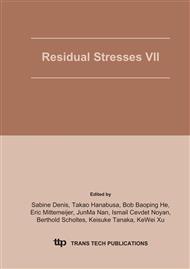p.545
p.552
p.558
p.564
p.571
p.577
p.583
p.589
p.595
Measurements of the Residual Stresses due to Cement Polymerization for Cemented Hip Implants
Abstract:
The initial fixation of the cemented hip prosthesis relies on the resistance of the interface between the metallic stem of the implant, the PMMA, and the adjacent bone. During the operation, the bone cement still in a liquid form is inserted between the implant and the bone. During polymerisation of the cement, residual stresses are generated in the bulk cement. An experiment has been devised to reproduce the in vivo behaviour of a cemented hip prosthesis, and to develop a technique to measure the residual stresses of the bone cement at the stem-cement interface. An idealized prosthesis (19-mm diameter) was placed inside a synthetic bone (outer diameter of 40 mm, inside diameter of 30 mm). The bone cement was poured between the stem and the bone. A sub-miniature load cell was inserted inside the idealized stem to measure directly the radial stresses generated by the cement curing on the hip stem. The tests are conducted at body temperature of 37°C to simulate the in-vivo conditions.
Info:
Periodical:
Pages:
571-576
Citation:
Online since:
July 2005
Authors:
Price:
Сopyright:
© 2005 Trans Tech Publications Ltd. All Rights Reserved
Share:
Citation:


